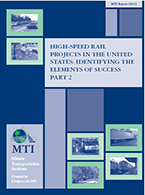- 408-924-7560
- mineta-institute@sjsu.edu
- Donate
High-Speed Rail Projects in the United States: Identifying the Elements of Success-Part 2
In August 2005, the Mineta Transportation Institute issued the report, High-Speed Rail Projects in the United States: Identifying the Elements for Success. The report noted that since the 1960s, highspeed ground transportation (HSGT) has “held the promise of fast, convenient, and environmentally sound travel for distances between 40 and 600 miles.” After briefly discussing the different experiences with HSGT between the United States and its Asian and European counterparts, the report proceeded to review three U.S. cases—Florida, California, and the Pacific Northwest—as a means for identifying lessons learned for successfully implementing high-speed rail (HSR) in the United States.
This report is, in essence, volume 2 of the previous study. Also using a comparative case study approach, this effort adds to the earlier work with three additional cases—the Chicago Hub, the Keystone Corridor, and the Northeast Corridor (NEC). As with the earlier report, the goal of this study is to identify lessons learned for successfully implementing HSR in the United States. Given the early stages of most of these projects, “success” is defined by whether a given HSR project is still actively pursuing development or funding. However, in the case of the Northeast Corridor, a fuller discussion of success is provided since HSR has been implemented on that corridor for some time now.
-
Contact Us
San José State University One Washington Square, San Jose, CA 95192 Phone: 408-924-7560 Email: mineta-institute@sjsu.edu






